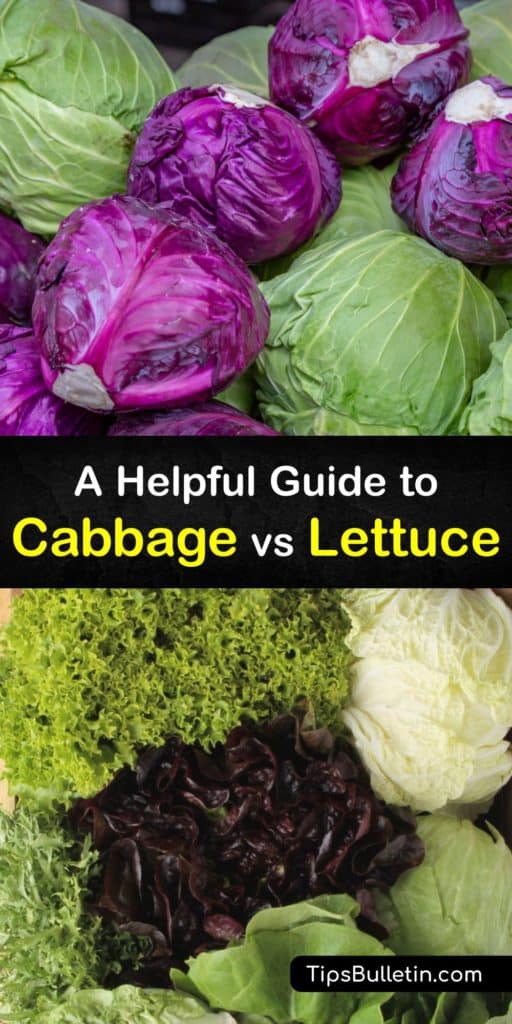These days, leafy greens are all the rage, and for a good reason. Not only are they nutritious, but there are many culinary uses for greens such as lettuce and cabbage. We discuss the differences and similarities of cabbage vs lettuce, their nutritional value, and health benefits and provide you with tips for growing your own at home.
There are so many ways to use leafy vegetables, whether you enjoy cabbage in coleslaw and cabbage soup or lettuce leaves in a crisp and tasty salad. There are many types, from red cabbage and green cabbage to romaine lettuce and iceberg lettuce. But, what’s the difference between cabbage vs lettuce, and is one type better than the other?
Several factors play a role in how these veggies differ from each other and include water content, flavor, texture, appearance, nutritional benefits, and the type of cabbage or lettuce.

The Difference between Cabbage and Lettuce
There is nothing more delightful than a hearty sandwich filled with deli meats, cheese, and lettuce with a side of creamy coleslaw, and all you need is a head of lettuce, a cabbage, and the sandwich fixings. But, is cabbage and lettuce the same thing?
While it’s simple to tell the difference between many vegetables, leafy greens are often confusing. Some of them have similar color and texture but they do not have the same taste and health benefits.
Learn the difference between cabbage and lettuce, their nutritional values, and ways to grow them in the garden.
Are Cabbage and Lettuce the Same Thing?
Is cabbage and lettuce the same thing? While they have a similar appearance, they are actually quite different regarding flavor and texture. To complicate matters more, there are several different types of cabbage and lettuce.
What is a cabbage, and how is it different from lettuce? Cabbage is one of the cruciferous vegetables, and it comes from the family of Brassicaceae, while lettuce is from the Asteraceae family. There are many varieties of both lettuce and cabbage.
The different types of cabbage (Brassica oleracea) include red, green, savoy, Napa cabbage, and bok choy. Green and red cabbage are compact and solid and are common in salads and slaws.

Savoy is a curly cabbage with deeply ridged and ruffled leaves and is delicious in stir fry. Napa cabbage, or Chinese cabbage, looks like a cross between Swiss chard and Romaine lettuce with the perfect flavor for kimchi.
Bok choy has distinct leaves that grow from a center stalk and is common for use in stir-fries.
There are many different varieties of lettuce (Lactuca sativa) as well. However, lettuce falls into four main categories, butterhead, crisphead, romaine, and loose-leaf.
Butterhead lettuce grows in small, round, and loose heads, while crisphead lettuce grows in tight cabbage-like heads with a crisp texture. Iceberg lettuce is a prime example of this type.
Romaine or cos lettuce grows with an elongated head of long, deep green leaves, and leaf lettuce does not grow as a head, but rather loosely packed leaves joined together at a stem.
What is the Difference between Cabbage and Lettuce?
With the wide variety of lettuces and kinds of cabbage, it gets confusing knowing which ones to use for recipes. We explain the difference between cabbage and lettuce for eating, cooking uses, and storage.
What is a lettuce, and how is it different from cabbage? While certain cabbage and lettuce types look somewhat the same, they are different when it comes to flavor.
Both are useful for a high fiber diet, but lettuce has fewer calories, and their culinary uses vary greatly. This is similar to benefits of kale and spinach as part of a healthy eating plan.
Lettuce tastes best raw and fresh on sandwiches and in a salad, while cabbage is better for cooking in stews, stir fry, and other hot dishes or raw in salads such as coleslaw.
Cabbage keeps better in the fridge as well. It’s important to properly store fresh romaine lettuce and cabbage so they last longer. While lettuce lasts up to one week, in the fridge cabbage is good for three weeks or more under the right conditions.
To store your leafy greens, remove the outer leaves, and place the lettuce or cabbage in a plastic bag with a damp paper towel and keep it in the crisper drawer of your refrigerator.
Nutritional Value of Cabbage vs Lettuce
Figuring out how lettuce and cabbage differ is one thing, but what about their nutrition? Both leafy greens are healthy to eat, but the amount of vitamins and minerals they contain differs.
Discover the nutritional value of these veggies to help you choose the right one for your diet.
Both lettuce and cabbage contain potassium, dietary fiber, vitamin K, manganese, chlorophyll, and vitamin C, but lettuce has slightly more than cabbage.
Lettuce has small amounts of calcium, magnesium, folic acid, and iron and is a good source of vitamin A. On the other hand, cabbage has more folate, and neither of them is a reliable source of vitamin B6.
Both veggies are great if you are on a high fiber diet or weight loss program. They both contain powerful antioxidants with anti-inflammatory properties that also help boost the immune system and lower cholesterol.
Is Cabbage and Lettuce Easy to Grow?
Producing your own vegetables is a wonderful way to boost a healthy diet, and it’s a great way to ensure you harvest organic food. Here are some helpful tips for growing leafy greens in your veggie garden using the right growing conditions.
Lettuce and cabbage are cool-season crops, so it’s an excellent idea to plant your seeds in the early spring. Growing iceberg lettuce indoors is also and easy and fun project. Plant cabbage in pots the same way and enjoy veggies year-round.
Prepare a garden bed as soon as the ground is easy to work, and sow the seeds a quarter-inch deep and four to six inches apart. If you have sandy soil, add organic matter to the garden.
Consider sowing seeds every two weeks to ensure that you get a crop of continuous veggies. Water the seeds right after planting so they are damp but not drenched, and feed the garden with an organic fertilizer for three weeks.
Pick an area of your yard where the garden gets at least six hours of sunshine daily, and make sure the soil is loose and well-draining, so the plants remain moist but not soggy. Also, make sure to rotate your crops each year to halt the spread of disease.
If you notice that your plants are too crowded, thin them out after they have three to four true leaves and spread mulch over the garden to retain moisture and stop weeds from taking over.
Cover the plants with a shade cloth to prevent them from bolting if the temperatures get unexpectedly warm. Consider planting lettuce and cabbage behind taller plants to provide shade from the hot afternoon sun. While vegetables are not typically grown in full shade, they appreciate some cover during the hottest part of the day.
Harvest cabbage and heads of lettuce when they are mature and firm, and clip loose leaf lettuce as needed by removing the outer leaves.
To harvest cabbage and iceberg lettuce, grasp the base of the head with a gloved hand and give it a firm tug to pull out the entire plant or use a sharp knife to remove the head from the short stem.
We recommend harvesting your plants in the morning before the leaves are exposed to the sun and they are still crispy.
Cabbage takes about 80 to 180 days to mature when you grow them from seed, while iceberg lettuce takes roughly 55 to 90 days. Romaine lettuce takes 60 to 80 days, and loose-leaf lettuce 45 to 55 days to mature.
Do Lettuce and Cabbage Taste Good Together?
Cabbage and lettuce share some of the same characteristics, but their tastes vary. However, they do complement each other when you prepare them in recipes. This cabbage tossed salad is the perfect way to bring the flavor of these two veggies together.
Fill a large bowl with chopped cabbage, lettuce, celery, and green onions and toss them. In another bowl, combine the oil, vinegar, sugar, salt, garlic powder, and black pepper.
Drizzle the dressing over the salad, toss it to coat the veggies completely, and chill it for 30-minutes before serving.
There are many benefits of consuming leafy greens, such as lettuce and cabbage. However, it’s important to understand how these veggies differ from each other when deciding how to grow them and incorporate them into your diet.

Knowing the difference between cabbage vs lettuce goes a long way when preparing recipes, so why not share our cabbage and lettuce nutrition and growing guide with your circle of family and friends on Pinterest and Facebook?